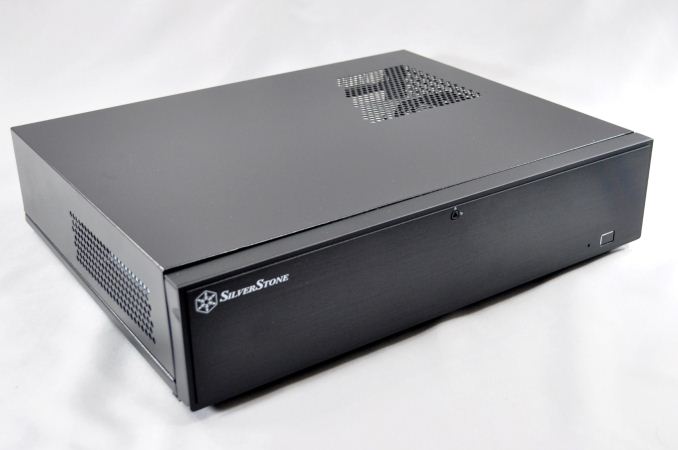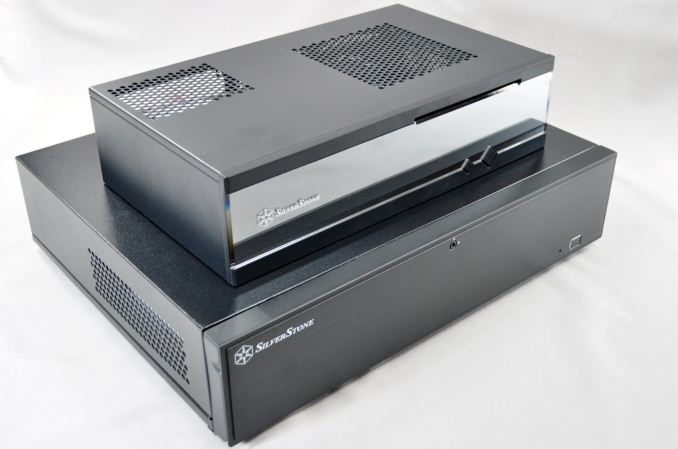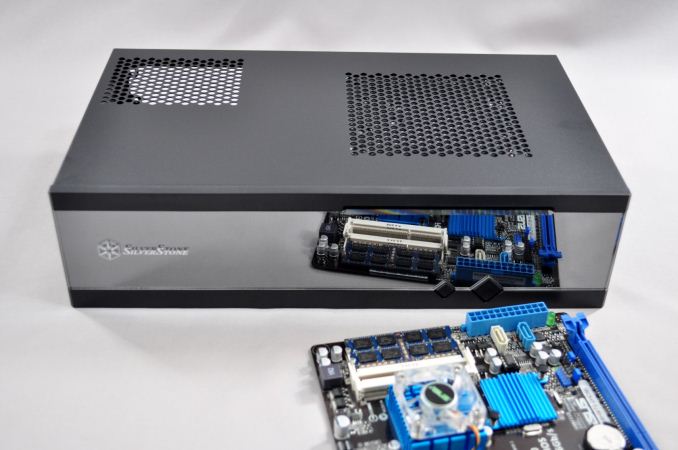SilverStone ML04 & ML05 Slim HTPC Cases Review
by E. Fylladitakis on April 18, 2014 2:30 PM EST- Posted in
- Cases/Cooling/PSUs
- HTPC
- SilverStone
- desktops
Final Words
Slim desktop cases are a special category of products that typically do not adhere to design conventions and thus their size, flexibility, and compatibility depends on the designer/manufacturer alone. It would be a mistake to compare them directly with other case designs that have been made with entirely different goals in mind. As they are designed to fit into cabinets and match A/V equipment, their compact proportions dictate that sacrifices need to be made. With both the Milo ML04 and the Milo ML05, Silverstone is trying to balance just about everything; compatibility with common components, upgradeability, aesthetics, and a reasonable price tag. The size of the cases will inevitably come with certain limitations, mostly on the compatibility and upgradeability fronts.
These limitations are not extremely significant with the Milo ML04, as it can hold Micro-ATX motherboards, common ATX PSUs, and 3.5"/5.25" drives. There are limitations regarding their size and only a small number of drives may be installed, but such components are common and relatively cheap. It is not difficult to build a very good HTPC inside the Milo ML04, and you can even install a modern low profile GPU, such as an R7 250 or GT 640, for some casual gaming (and improved video codec support). With an R7 250 installed, the system should be capable of handling 4K video material as well. Considering the 0.016 cubic meters this case occupies and the height of only 105mm, that's not bad at all.
Despite the fact that the Milo ML04 is their entry-level slim HTPC case, Silverstone paid attention to many little details and features. For example, it is possible to lock the power button on the door to prevent children from pressing it, and a simple dimmer has been installed to lower the intensity of the power-on LED if the user finds it annoying. The company also reinforced the chassis and tried to make it as versatile as possible, allowing end users to choose their ideal configuration. However, each component selection sacrifices something else. For example, if you install an optical drive, you cannot use the same cage to install a 3.5" or 2.5" drive. If you choose to go with a 2.5" drive on the plastic cage, you cannot install a 3.5" device there as well. Moreover, if you choose to go with a full height expansion card by using a riser, you severely limit the height of the CPU cooler.
Aesthetics are a subjective matter but we feel that certain things could be improved. It is understandable that Silverstone focused all of their attention on the faceplate, as it will be the only directly visible aspect if the Milo ML04 is installed inside a cabinet. However, in any other scenario, the body of the Milo ML04 will look entirely out of place. Moreover, some other details could be improved, such as the massive gap between the plastic faceplate and the metallic chassis, which is obvious once the door opens. We have to stress that this is an entry-level HTPC case however, retailing for $74.99, so we cannot ask too much from it.
Silverstone reduced the proportions of the Milo ML05 even more, creating a tiny design that is very discreet. Although it's not as small as the Antec ISK 110, the Milo ML05 is a good compromise between minimum proportions and the more versatile Milo ML04. As the Milo ML05 is smaller than the vast majority of A/V equipment, it is most likely intended for a minimalistic environment comprised of just a tiny HTPC and a nice TV, rather than to match other A/V equipment. The tiny size of the Milo ML05 however reduces upgradeability and versatility even more. Aside from the obvious motherboard size limitation, as only Mini-ITX boards may be installed, only SFX PSUs will fit -- tightly. If the multipurpose bracket is used for an optical drive or extra cooling, the installation of a 3.5" drive is not possible at all. Even if a 3.5" drive is installed on the multipurpose bracket, it will reduce the maximum height of the CPU cooler by several milimeters.
It is very easy to be lured by the very low retail price of the Milo ML05, which currently sells for just $39.99 incl. shipping. However, the low retail price is misleading, as the components required to build such a small system can be quite expensive. The SFX PSU is not much of a problem, as a low-capacity unit should not cost more than $50. If you wish to include an optical drive, however, you can only use a slot-loading slim SATA drive that will cost $69.60. If you skip the optical drive, you may install additional cooling or drives, or nothing at all; in any case, you will end up with a useless slot across the faceplate of the system, as there is no way of hiding it.
Building a budget HTPC in the Milo ML05 is still possible. It is not difficult to find a board with an integrated CPU for less than $100 (our demo Asus C8HM70-I/HDMI retails for $78.99) and a quality SFX PSU for $54.99. Add some RAM and a mechanical 2.5" HDD and you will probably manage to have a fair HTPC for less than $250 total. This is not all that bad for a case that occupies less than one fourth the volume of a Mini-ITX case designed to take high-performance GPUs, such as the Obsidian 250D.
If you want more power and/or features, with a proper selection of components the Milo ML05 can become a small powerhouse; however, the price will start increasing rapidly as well. The optical drive alone will cost over $60 and an 1150/FM2 based board with a good CPU will increase the budget by at least a hundred dollars. If you want to add a good low profile GPU, that will be yet another hundred dollars more. Then you will have to seek a low profile CPU cooler and most likely you'll want to install an SSD as well, bringing up the cost of the system from about $250 to about $650-700. While it may be interesting that you can build a rather powerful system within such small proportions, it can be a costly endeavor and we do not really recommend it, unless the intended use of the system is much more than just typical HTPC functions.
Overall, the Silverstone ML04 and ML05 are reasonable cases, and provided you're aware of their limitations -- and are willing to put a bit more time into researching the best components as well as assembling the system -- they can work well as entry-level HTPCs. If you want something more versatile, you'll generally sacrifice on size at the least, and perhaps cost as well, while devices that are even smaller will have to cut additional features. As a low priced alternative to other HTPC enclosures, the ML04 and ML05 fill a niche and should keep their intended users happy.













39 Comments
View All Comments
Meaker10 - Friday, April 18, 2014 - link
Wow F-I90HD, that brings back memories, one of the first generation of performance based uATX options.homer_pickett - Thursday, October 9, 2014 - link
I agree, it does bring back memories. But I don't get how it's going to stand a chance on todays market. /Homer from http://www.consumertop.com/best-desktop-guide/britjh22 - Friday, April 18, 2014 - link
I think the MLO5 set up with the ASRock AM1H-ITX, Kabini Athlon 5350, a SSD and just use the DC in with a laptop power brick would be an awesome media front end for a basic FreeNas setup. That Keep the budge fairly low since you don't have to worry about SFX PSU's.johnny_boy - Saturday, April 19, 2014 - link
There are much better options if you don't need the graphics power of the 5350, which you wouldn't for freenas.teldar - Saturday, April 19, 2014 - link
Have it. No case. Just a bare power switch, while thing mounted on lexan on back of tv. Motherboard gets hot with the dc in. But a good little computer. Using 120gb crucial m500.DanNeely - Friday, April 18, 2014 - link
(all switching PSUs are extremely efficient if the magnitude of the load is below 20% of their rated capacity).this is backwards; very low (or high) loads result in inefficient performance, although with the newest efficiency standard specifying performance levels at 10/90% the efficient operation range is being forced wider (there's not much room left to improve in the middle any more).
E.Fyll - Friday, April 18, 2014 - link
That actually was a typographic mistake on my part (efficient instead of inefficient). It has been corrected. Thank you.Samus - Friday, April 18, 2014 - link
Ive been using an ml05 for awhile with a Pico PSU (90w) and a Brazos E350. Ive been looking into upgrading the board (and CPU) for awhile but keep putting it off hoping for more sub-20-watt desktop CPU options, although the new AMD A1 at 25watt is on the hot list right now. It seems to be the natural successor to Brazos, which to this day is still surprisingly competent.jlockheart - Friday, April 18, 2014 - link
I like the smaller size of the Milo ML04, constraints can sometimes make you more creative. For the full PCI slot above the motherboard I wound up using 4-port USB and ran the cables back to headers on my mobo. Also made good use of the VGA knockout with a spare half height AMD 5450.Brainonska511 - Friday, April 18, 2014 - link
A few years ago, I built my htpc system with an ML03b case. Looks to be the same design as the ML04, minus that weird faceplate on the ML04. It's been pretty solid. As far as airflow, I threw 2 quiet 80 mm fans on the side mounts, to help pull some air through the case. As for the noise the system produces: between the Scythe Big Shuriken heatsink (120mm slim fan), 2 80mm fans, and a PSU fan, I can't really hear it in a silent room if I'm more than 3 feet away. If you're watching something on TV, then any noise is drowned out completely.